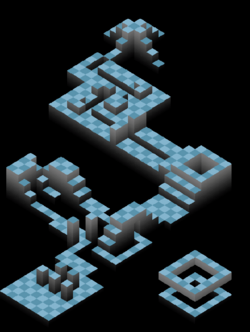Software:Level (video gaming)
A level, map, area, stage, world, track, board, floor, zone, phase, mission, episode, or course in a video game is the total space available to the player during the course of completing a discrete objective. Video game levels generally have progressively increasing difficulty to appeal to players with different skill levels.[1] Each level presents new content and challenges to keep player's interest high.[1]
In games with linear progression, levels are areas of a larger world, such as Green Hill Zone. Games may also feature interconnected levels, representing locations.[2]
Level design
Level design or environment design is a discipline of game development involving creation of video game levels—locales, stages, or missions.[3][4][5][6] This is commonly done using a level editor, a game development software designed for building levels; however, some games feature built-in level editing tools. Level design is both an artistic and technical process.[7]
Bonus stage
A bonus stage (also known as a bonus level or bonus round) is a special level within a video game designed to reward the player or players, and typically allows the player to collect extra points or power-ups. Bonus stage either have no enemies or hazards, or replace the normal penalties for being struck by enemies or hazards with simply being thrown out of the bonus stage. Many bonus stages need to be activated or discovered in some manner, or certain conditions must be satisfied to access them. Otherwise, they appear after the player has completed a certain number of regular stages.[8]
See also
Sources
- Scott Rogers (16 April 2014). Level Up! The Guide to Great Video Game Design. Wiley. ISBN 978-1-118-87719-7. https://books.google.com/books?id=UT5jAwAAQBAJ.
- Lewis Pulsipher (25 July 2012). Game Design: How to Create Video and Tabletop Games, Start to Finish. McFarland. ISBN 978-0-7864-9105-6. https://books.google.com/books?id=SkAJt4gdgwoC.
- Guy W. Lecky-Thompson (1 January 2008). Video Game Design Revealed. Cengage Learning. ISBN 1-58450-607-5. https://books.google.com/books?id=3aQLAAAAQBAJ.
- Bates, Bob (2004). Game Design (2nd ed.). Thomson Course Technology. ISBN 1-59200-493-8.
- Brathwaite, Brenda; Schreiber, Ian (2009). Challenges for Game Designers. Charles River Media. ISBN 1-58450-580-X.
- Moore, Michael E.; Novak, Jeannie (2010). Game Industry Career Guide. Delmar: Cengage Learning. ISBN 978-1-4283-7647-2.
- Oxland, Kevin (2004). Gameplay and design. Addison Wesley. ISBN 0-321-20467-0.
- Shahrani, Sam (April 25, 2006). "Educational Feature: A History and Analysis of Level Design in 3D Computer Games". http://www.gamasutra.com/view/feature/2674/educational_feature_a_history_and_.php. Retrieved 5 January 2011.
References
- ↑ 1.0 1.1 Schell, Jesse (2014). The Art of Game Design: A book of lenses. Pittsburgh, Pennsylvania, USA: CRC Press. pp. 120, 252. https://books.google.co.uk/books?hl=tr&lr=&id=kRMeBQAAQBAJ. Retrieved 30 December 2017.
- ↑ McGuire, Morgan; Jenkins, Odest Chadwicke (2009). Creating Games: Mechanics, Content, and Technology. Wellesley, Mass.: AK Peters. p. 104. ISBN 978-1-56881-305-9.
- ↑ Oxland 2004, pp.21-22,126
- ↑ Bates 2004, p.107
- ↑ Brathwaite, Schreiber 2009, p.5
- ↑ Shahrani 2006, part I
- ↑ Bleszinski, Cliff (2000). "The Art and Science of Level Design". Archived from the original on 3 December 2002. https://web.archive.org/web/20021203193328/http://www.cliffyb.com/rants/art-sci-ld.shtml. Retrieved 29 March 2010.
- ↑ "The Next Generation 1996 Lexicon A to Z". Next Generation (Imagine Media) (15): 30. March 1996. "Typically, bonus levels are either hidden and require discovery or appear after a certain number of regular levels have been completed.".




